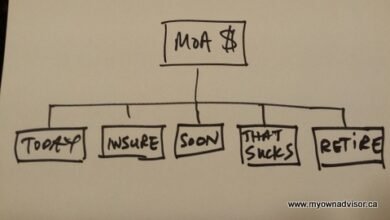استراتيجيات ذكية للاستثمار في التقاعد عندما يصبح الوقت عدوك!

the key points on how to invest for retirement when time is no longer your friend, especially for someone starting later in life.
1. Maximize Your TFSA Contributions
– Since you have an empty Tax-Free Savings Account (TFSA), aim to maximize your contributions. As of 2024, the contribution limit is $7,000 per year. If you haven’t contributed before and are eligible, your total contribution room could be up to $95,000.
– Plan to contribute the maximum amount each year and catch up on any missed contributions as soon as possible.
2. Focus on Growth Investments
– Given that you have a long-term horizon of about 15 years until age 70, consider investing primarily in equities or equity-focused ETFs like XAW (which offers broad exposure to global markets). Historically, equities tend to provide higher returns over the long term compared to bonds or cash.
- Aiming for a solid rate of return (e.g., around 6% annually) can significantly enhance your investment growth over time.
3. Stay Invested
– Avoid trying to time the market; instead, adopt a buy-and-hold strategy where you stay invested through market fluctuations.
– The power of compounding works best when investments are left untouched for extended periods.
4. Diversify Your Portfolio
– While focusing on growth is essential, ensure that your portfolio remains diversified across different sectors and asset classes. This can help mitigate risks associated with market volatility.
5. Consider Professional Advice
– If you’re unsure about managing investments yourself or if day trading seems appealing but risky at this stage in life, consider consulting with a financial advisor who can help tailor an investment strategy suited for your goals and risk tolerance.
Conclusion
Investing later in life may seem daunting due to limited time until retirement; however, by maximizing contributions into tax-advantaged accounts like TFSAs and focusing on disciplined investing strategies—such as staying invested in growth-oriented assets—you can still build substantial wealth by retirement age.
Remember: It’s never too late to start investing wisely!It seems like you’re sharing a detailed article about investing for retirement, particularly focusing on the Tax-Free Savings Account (TFSA) in Canada. The article discusses strategies for maximizing retirement savings when time is limited and emphasizes the importance of disciplined investing.
Here’s a summary of the key points from your text:
Key Points on Investing for Retirement with TFSA
- TFSA Contributions:
– The maximum lifetime contribution limit to a TFSA is $95,000 if you turned 18 before 2009 and have never contributed.
– For 2024, the annual contribution limit is $7,000.
– If you withdraw funds from your TFSA, that amount is added back to your contribution room in the following year.
- Investment Strategy:
– A disciplined approach to saving and investing within your TFSA can significantly contribute to your retirement plan.
- It’s suggested to invest primarily in equities through low-cost ETFs (like XAW) with an expected return rate of around 6%.
– Avoid day trading; instead, consider long-term investments that align with wealth-building goals.
- Risk Management:
– Understand that all investments carry risk; however, staying invested generally leads to better long-term outcomes compared to trying to time the market.
- Diversification across different asset classes can help mitigate risks associated with market volatility.
- Avoiding Financial Pitfalls:
- Be cautious of financial institutions whose primary goal may be profit rather than client success.
– Keep investment fees low and focus on building a diversified portfolio without falling prey to high-pressure sales tactics from financial advisors or brokers.
- Long-Term Wealth Building:
- Consistent contributions over time can lead to substantial growth within a TFSA due to its tax-free nature.
– Consider various investment options available within TFSAs such as stocks, bonds, GICs (Guaranteed Investment Certificates), and ETFs.
Conclusion
The article concludes by emphasizing that while it’s difficult to predict market movements or returns accurately over short periods, maintaining a steady investment strategy focused on long-term growth will likely yield positive results as one approaches retirement age.
If you have any specific questions or need further information about any aspect mentioned in this summary or related topics regarding retirement planning and investing strategies using TFSAs or other accounts, feel free to ask!It seems like you’ve shared a detailed article about investing in a Tax-Free Savings Account (TFSA) and its potential benefits for retirement planning in Canada. The author, Mark Seed, discusses his hybrid investing approach and emphasizes the importance of using TFSAs for tax-free growth. Here are some key takeaways from the content:
- TFSA Benefits: The TFSA allows Canadians to invest after-tax dollars in various assets such as cash, GICs, bond funds, individual stocks, and equity ETFs without incurring taxes on growth or withdrawals.
- Investment Strategy: Mark mentions that he personally invests in a mix of Canadian stocks and low-cost diversified ETFs within his TFSA. He plans to continue adding ETF units over time.
- Contribution Limits: For 2024, the TFSA contribution limit is $7,000. If you have never contributed before and turned 18 before 2009, your total contribution room could be up to $95,000.
- Long-Term Growth Potential: By contributing $77,000 now and continuing to max out contributions over the next decade with an assumed annual return of 6%, individuals can build significant wealth by age 70 alongside other retirement benefits like CPP (Canada Pension Plan) or OAS (Old Age Security).
- Investment Considerations:
– Investors should be aware that all investment decisions involve trade-offs.
– A disciplined approach to saving and investing is crucial.
- It’s recommended to avoid day trading for long-term wealth building; instead focus on low-cost equity ETFs.
- Resources for Further Learning: The article provides links to additional resources on topics such as retiring on a lower income or generating retirement income.
this piece serves as both an informative guide for Canadians looking at their investment options within TFSAs while also encouraging thoughtful long-term financial planning strategies tailored towards achieving financial independence by retirement age.




